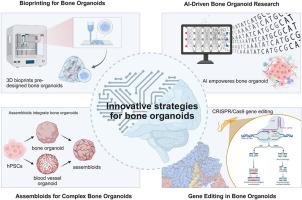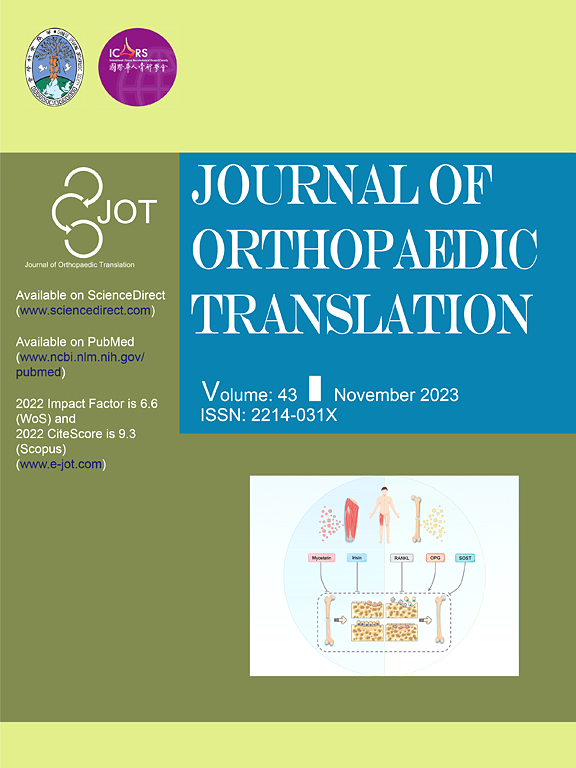Innovative strategies for bone organoid: Synergistic application and exploration of advanced technologies
IF 5.9
1区 医学
Q1 ORTHOPEDICS
引用次数: 0
Abstract
Bone organoids, as three-dimensional (3D) biomimetic constructs, have emerged as a promising platform for studying bone development, disease modeling, drug screening, and regenerative medicine. This review comprehensively explores innovative strategies driving bone organoid advancements, emphasizing the integration of cutting-edge technologies such as bioprinting, artificial intelligence, assembloids, and gene editing. While 3D bioprinting enhances spatial precision and structural complexity, artificial intelligence accelerates organoid optimization through data-driven approaches. Assembloids enable the assembly of multicellular systems to better replicate bone tissue microenvironments, whereas gene editing refines disease modeling and functional modifications. Despite these advancements, challenges remain, including the lack of vascularization, insufficient mechanical stimulation, and standardization issues across different models. Also, the clinical translation of bone organoids necessitates the establishment of rigorous evaluation frameworks, ethical guidelines, and regulatory policies to ensure their reproducibility and safety. Looking ahead, interdisciplinary convergence will be critical for constructing physiologically relevant “ex vivo skeletal systems”, advancing bone biology, precision medicine, and biomaterial testing. This review highlights the transformative potential of bone organoid technology and its future applications in personalized orthopedics and bone disease intervention.
The Translational Potential of this Article
This review provides a comprehensive overview of cutting-edge strategies for constructing bone organoids, emphasizing their integration with advanced technologies such as bioprinting, artificial intelligence, assembloids, and gene editing. By systematically discussing their applications in bone development, disease modeling, drug screening, and regenerative medicine, this article bridges the gap between experimental models and clinical translation. The insights into vascularization, skeletal patterning, and high-throughput screening platforms offer a foundation for developing physiologically relevant bone organoids with enhanced fidelity and functionality. These advancements hold significant potential for accelerating personalized medicine, facilitating preclinical evaluation of therapeutics, and ultimately improving treatment outcomes for skeletal diseases.

类骨器官的创新策略:协同应用和先进技术的探索
骨类器官作为三维(3D)仿生结构,已成为研究骨骼发育、疾病建模、药物筛选和再生医学的一个有前途的平台。本文全面探讨了推动骨类器官发展的创新策略,强调了生物打印、人工智能、组装体和基因编辑等前沿技术的整合。3D生物打印提高了空间精度和结构复杂性,而人工智能通过数据驱动的方法加速了类器官的优化。组装体使多细胞系统的组装能够更好地复制骨组织微环境,而基因编辑则改进了疾病建模和功能修饰。尽管取得了这些进步,但挑战依然存在,包括缺乏血管化、机械刺激不足以及不同模型之间的标准化问题。此外,骨类器官的临床翻译需要建立严格的评估框架、伦理准则和监管政策,以确保其可重复性和安全性。展望未来,跨学科的融合对于构建生理学相关的“体外骨骼系统”、推进骨生物学、精准医学和生物材料测试至关重要。本文综述了类骨器官技术的变革潜力及其在个性化骨科和骨病干预方面的未来应用。本文综述了构建骨类器官的前沿策略,强调了它们与生物打印、人工智能、组装体和基因编辑等先进技术的结合。本文通过系统地讨论它们在骨骼发育、疾病建模、药物筛选和再生医学中的应用,弥合了实验模型和临床翻译之间的差距。血管化,骨骼模式和高通量筛选平台的见解为开发具有增强保真度和功能的生理相关骨类器官提供了基础。这些进步在加速个性化医疗、促进治疗方法的临床前评估以及最终改善骨骼疾病的治疗结果方面具有巨大的潜力。
本文章由计算机程序翻译,如有差异,请以英文原文为准。
求助全文
约1分钟内获得全文
求助全文
来源期刊

Journal of Orthopaedic Translation
Medicine-Orthopedics and Sports Medicine
CiteScore
11.80
自引率
13.60%
发文量
91
审稿时长
29 days
期刊介绍:
The Journal of Orthopaedic Translation (JOT) is the official peer-reviewed, open access journal of the Chinese Speaking Orthopaedic Society (CSOS) and the International Chinese Musculoskeletal Research Society (ICMRS). It is published quarterly, in January, April, July and October, by Elsevier.
 求助内容:
求助内容: 应助结果提醒方式:
应助结果提醒方式:


